White Pass and Yukon Route, Skagway, Alaska
In May I made my first trip to Alaska, though not purely for photography. This is the 3rd of my on going series of posts detailing the photographic opportunities that I saw in the sites that I visited. I’ve already covered the first three experiences: a float plane trip to a remote mountain like in Misty Fjords National Mounment, a helicopter walkabout on Mendenhall Glacier, and finally hiking the Mount Roberts alpine loop trail in previous articles.
I have a long history with trains. Like many children I was fascinated by them as a kid. As I grew up I grew to appreciate their importance in the history of the development and sustainment of modern life as well as the aesthetics man made machinery in nature. As a photographer, historical railroads and the equipment that run on them provide yet another opportunity for creating interesting images. Moreover, many of these historical railroads, like the White Pass and Yukon Route, Durango and Silverton, or Cumbres and Toltec Scenic Railroad offer an easy way to see and experience many rugged areas that have largely escaped modern development.
A Bit of History
I’m not going to talk much about the early history of the White Pass and Yukon, as there’s not a whole lot of it left, outside of the route. For a more detailed overview, I recommend reading this article on Pacific Narrow Gauge. The short form is that in their way to profit from the 1896 gold rush in the Yukon territory, the White Pass and Yukon Route drove a rail like from Skagway, Alaska, through the Canadian provinces of British Colombia and the Yukon Territories, to Fort Selkirk, Yukon Territory.
In an effort to cut construction costs, the White Pass and Yukon was built a track gauge (the distance between the rails) of three feet instead of the standard of 4 feet 8 and 1/2 inches. Three-foot gauge was also a popular gauge for building out rail lines in Colorado in the mid–19th century as well. However, for railroads in the lower 48 the importance of being connected with the rest of the American rail network quickly saw the majority of those early 3 foot gauge lines being converted to standard gauge—only those that were too costly to upgrade were maintained by their owners until the 1950s and 1960s when roads provided sufficient access to areas that the railroads could be abandoned.
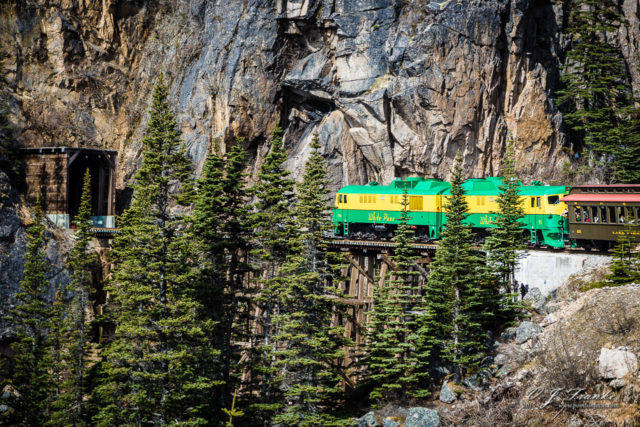
In each case, the economics worked out differently for the railroads in the lower 48 and the White Pass in Alaska and Canada. In the lower 48, the railroads that still had 3-foot gauge routes sought to spend as little as possible on them, and as a result their steam engines from the early 20th century survived well after steam had been replaced on every other mainline railroad.
However, since there was no other railroads to connect to, and thus no major impetus to convert the route to standard gauge, the railroad still needed motive power to handle the traffic. So while it’s southern counterparts were limping along with 20 year old or older steam engines in the 1950s, the White Pass was purchasing modern diesels to pull it’s trains.
In much the same way motive power changed, the white pass also adapted it’s shipping techniques. In the lower 48, in the places where narrow gauge trains had to interconnect with standard gauge trains, the cargos needed to be trans-loaded from one train to the other. This process was almost always a manual operation that was slow and cumbersome.
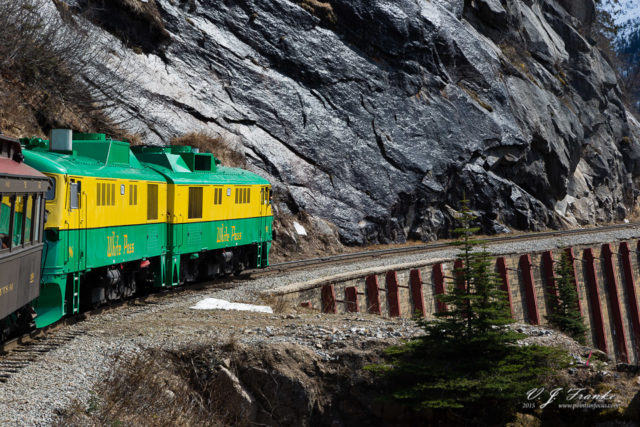
However, for the White Pass, most of its cargo was either ore going from mines to smelters in the lower 48, or mining supplies coming from the lower 48 to the mines. In both of these cases, the cargo had to travel by boat from Skagway to a port on the Pacific coast. The White Pass’s solution to this problem was to develop containerized cargo—a system that was the predecessor of the modern international containers used to transport virtually all manufacturers goods.
The result of the modernizations that the White Pass made, kept them around as an active freight railroad well into he 1980s. Business further diversified in the 1970’s when, cruise ships started calling on Skagway, and tourists started riding the line. Today, the line hauls tourists.
The historical setting though does create an interesting counter point to the contemporary 3-foot gauge tourist lines in the lower 48.
Photography Challenges and Opportunities
There are a number of varied photographic opportunities while riding the White Pass and Yukon route including pictures of the train and landscapes, along with a couple of major challenges.
There are three major challenges to shooting from the White Pass, none of which I found so onerous to make it impossible to shoot but some were more challenging that I have experienced in shooting from other narrow gauge tourist lines.
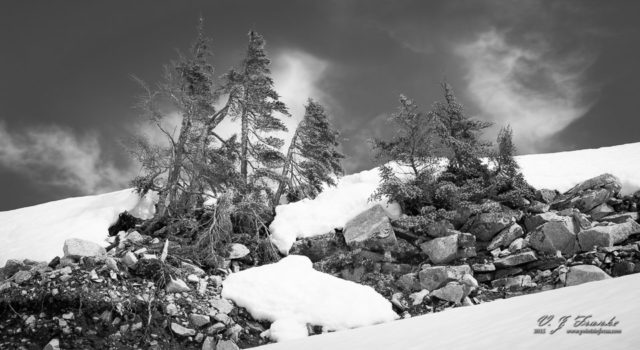
The first issue is that the cars, at least all the cars I saw, have fixed windows. If you’re seated in a car, which in some ways makes it easier to shoot from a stability perspective, you’ll be doing so through a glass window. The solution to the window problem is to go and stand out on the end platforms. Standing on the end platform solves the window issue, but adds a stability issue. Moreover, the end platforms are first come first serve, and you’re encouraged to not spend a lot of time on the platform to allow others the opportunity to go out and experience the ride form out there.
That said, if you’re a serious railfan or photographer, the biggest trick to getting a lot of time on the end platforms is to wait until later half of the trip—especially if it’s cold out. Keep in mind, the train moves at up to 30 MPH, and that adds a significant amount of wind chill on top of whatever the generally lower temps already are. In short, people get tired of standing and being cold, and go back inside—note this suggestion will almost certainly not apply to any railfan excursion.
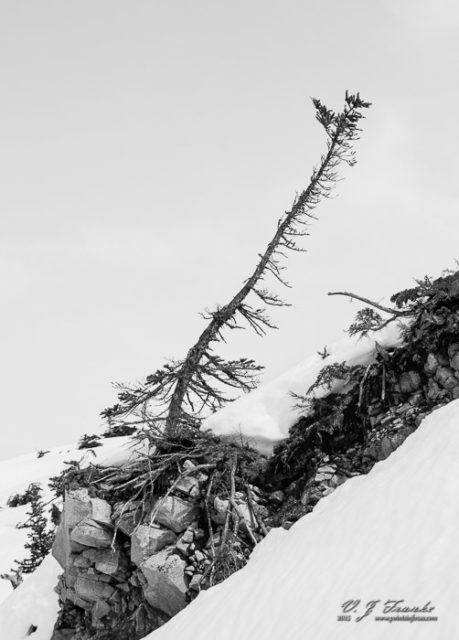
The other problem out on the platforms is being able to deal with the pitching and rolling of the train cars. Quite simply, it’s hard to both hold on and work a camera with two hands and not worry about falling. I don’t ride enough trains to have any kind of permanent “sea legs” or what have you, so I find it generally useful to spend a bit of time not worrying about shooting and just trying to get into the rhythm of standing steadily while the car rocks and rolls around me.
What might be the biggest challenge of the White Pass and Yukon is the speed the trains run at. As I noted, unlike the big 3-foot gauge tourist line in Colorado, the White Pass modernized and that modernization mean they can run generally pull tonnage faster. Instead of being limited by the pulling power of nearly 100 year old steam engines, the White Pass has modern (most of their engine fleet was rebuilt with very modern clean diesel engines in the last few years) engines that allow for comparatively higher operating speeds.
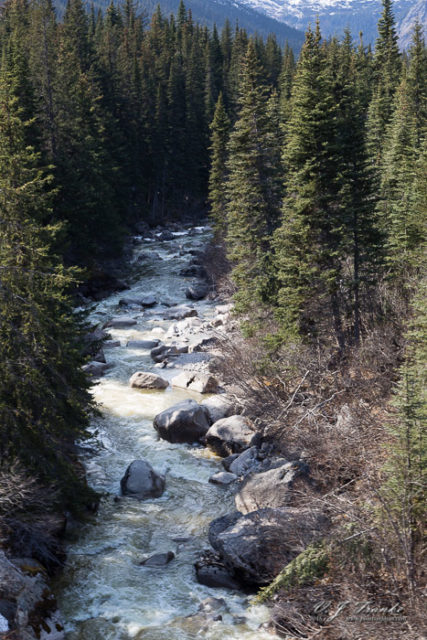
The speeds the trains operate at, especially when going down hill, means that you have to keep a close eye on your shutter speeds if you want to freeze the landscapes flying by. I found that a minimum of 1/500th to 1/1000th was necessary for anything in the foreground.
As for image stabilization, don’t expect it to help. The motion and speed of the train is simply too high for IS to provide any useful benefits. You need all the shutter speed you can get, and need to rely on the shutter speed to stop both camera shake and camera/subject motion.
So with the challenges out of the way, what can you expect to shoot.
A lot of that is going to depend on the weather when you’re riding. Clear days are going to present better opportunities than rainy or snowy ones.
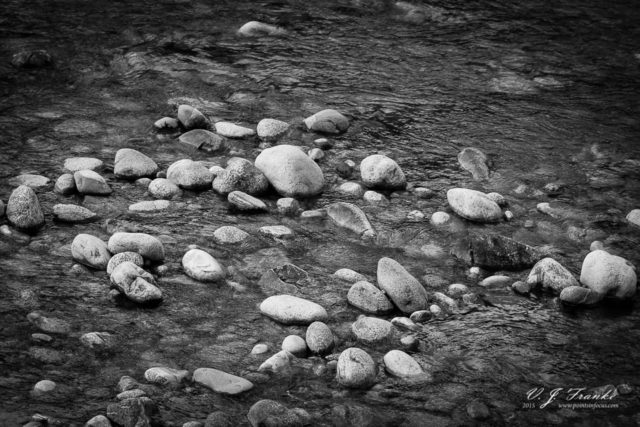
At low altitudes, the line travels through cotton wood and aspen groves that can render interesting forest abstracts. As the train climbs towards White Pass, the makeup of the forest changes with greater concentrations of evergreens. Additionally as the train climbs, the line increasingly becomes more precariously perched on the edge of cliffs providing spectacular views.
If you’re a railfan looking to photograph the trains, there are a number of options where the train curves on bridges or at the ends of valleys where the locomotives can be photographed from the middle and rear of the train. Additionally, there generally will be enough traffic that you can catch shots of the train ahead of yours across the valley at various points along the line.
At White Pass Summit, the exposed moderately high altitude makes a harsh environment for plants, and the conifers respond in kind with twisted and gnarled shapes. It’s also useful that for most trains the Summit is the point where the train stops and returns down hill to Skagway. This means that you’ll be stopped or moving quite slowly for a lot of the time at the summit.
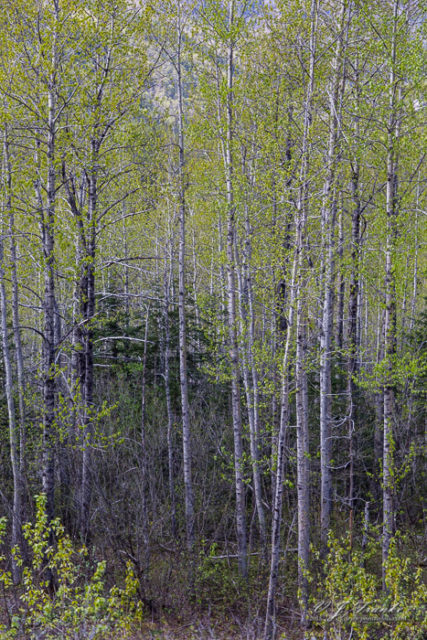
Additionally, the line passes through a lot of prime wilderness. Though wildlife is never a guaranteed opportunity, on the train I was on we saw a black bear (that crossed the tracks just ahead of the train) and a number of mountain goats.
I only went on the short trip (~3 hours) from Skagway to White Pass and return. However, the White Pass also offers longer excursions, up to 8 hours, over the full length of the operating line to Lake Bennett and historic gold rush town of Carcross, Yukon Territory and back.
I can’t say that taking the White Pass is a must do for anyone, let alone a serious photographer. Personally speaking, I would certainly ride the White Pass and Yukon again, but I also rather enjoy the experience of riding historic railroads as much as anything else.
Comments
There are no comments on this article yet. Why don't you start the discussion?